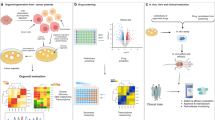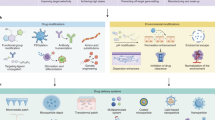Abstract
The optimal drug-light interval for effective photodynamic therapy (PDT) of early squamous cell carcinomas was evaluated with tetra(m-hydroxyphenyl)chlorin (mTHPC) by means of two complementary modalities: irradiation tests and ex vivo fluorescence microscopy. A Syrian hamster cheek pouch tumour model was used in these experiments. Photodynamic therapy on both tumour-bearing and contralateral healthy cheek pouch mucosae was performed at 650 nm and 514 nm. Light doses of 12 J cm(-2) were delivered at a light dose rate of 150 mW cm(-2) and light doses of 80 J cm(-2) were delivered at a light dose rate of 100 mW cm(-2) respectively, at these two wavelengths, between 6 h and 12 days after the injection of 0.5 mg kg(-1) body weight mTHPC. Two histologically different types of tissue damage were observed: first, a non-selective and non-specific ischaemic vascular necrosis for the cases in which PDT took place during the first 48 h after the injection of the dye and, second, tissue-specific PDT damage, as a coagulation necrosis, when PDT took place more than 72 h after injection of the dye. The time-dependent biodistribution of mTHPC investigated by fluorescence microscopy shows a weak and non-significant difference in relative fluorescence intensities between early SCC and healthy mucosae. Up to 2 days after the injection, the drug is mainly localized in the endothelial cells of the blood vessels. After this period, the dye accumulates in the squamous epithelia with a concentration peaking at 4 days. At all time points, a weak fluorescence intensity is observed in the underlying lamina propria and striated muscle. The information obtained from these studies could well be relevant to clinical trials as it suggests that time delays between 4 and 8 days after i.v. injection should be optimal for PDT of early malignancies in hollow organs.
This is a preview of subscription content, access via your institution
Access options
Subscribe to this journal
Receive 24 print issues and online access
$259.00 per year
only $10.79 per issue
Buy this article
- Purchase on Springer Link
- Instant access to full article PDF
Prices may be subject to local taxes which are calculated during checkout
Similar content being viewed by others
Author information
Authors and Affiliations
Rights and permissions
About this article
Cite this article
Andrejevic-Blant, S., Hadjur, C., Ballini, JP. et al. Photodynamic therapy of early squamous cell carcinoma with tetra(m-hydroxyphenyl)chlorin: optimal drug-light interval. Br J Cancer 76, 1021–1028 (1997). https://doi.org/10.1038/bjc.1997.502
Issue Date:
DOI: https://doi.org/10.1038/bjc.1997.502
This article is cited by
-
Selectivity of the photosensitiser Tookad® for photodynamic therapy evaluated in the Syrian golden hamster cheek pouch tumour model
British Journal of Cancer (2003)
-
Foscan® uptake and tissue distribution in relation to photodynamic efficacy
British Journal of Cancer (2003)



